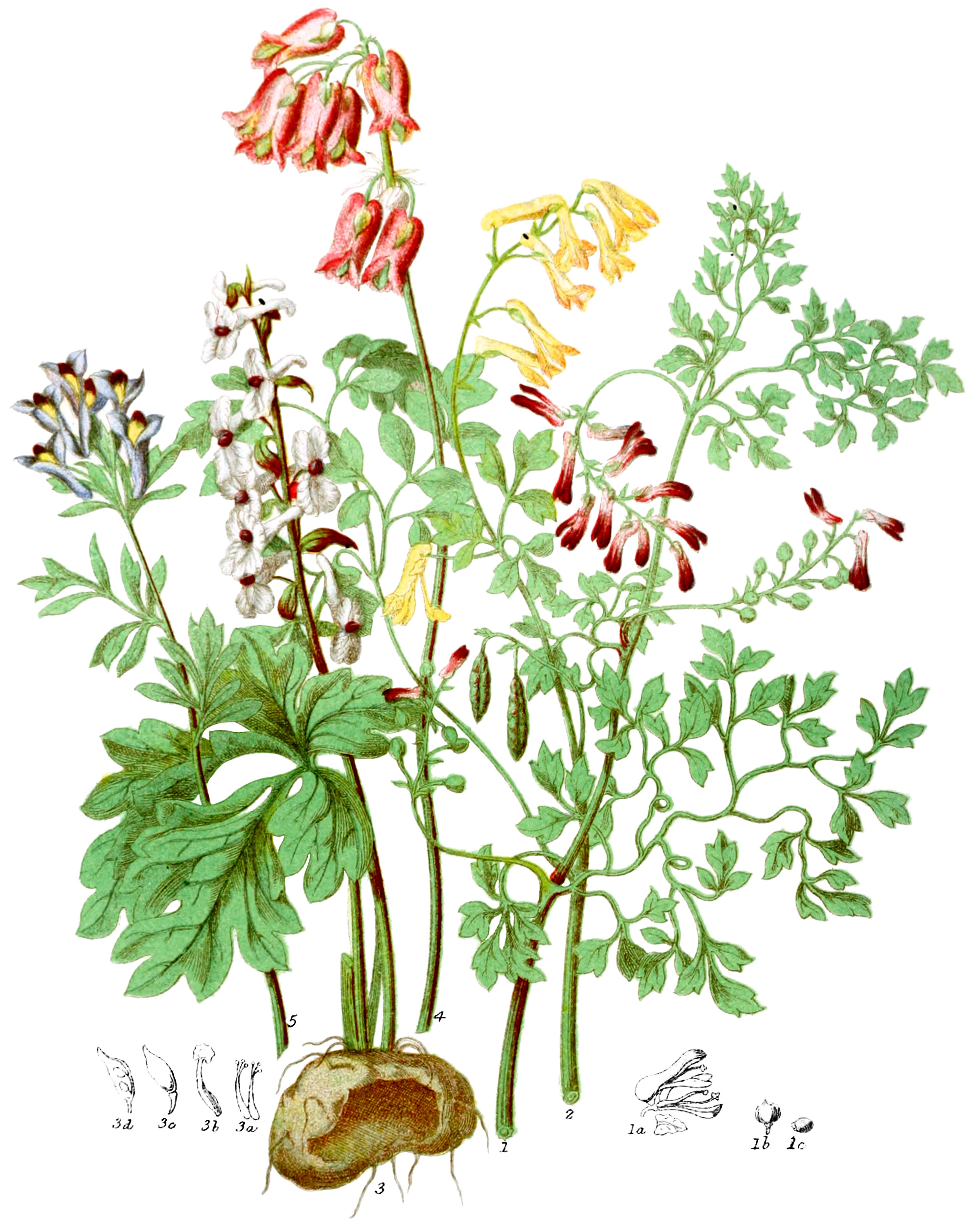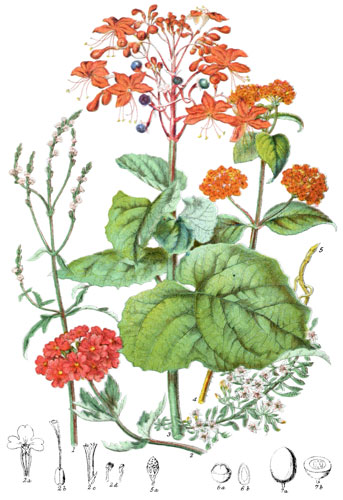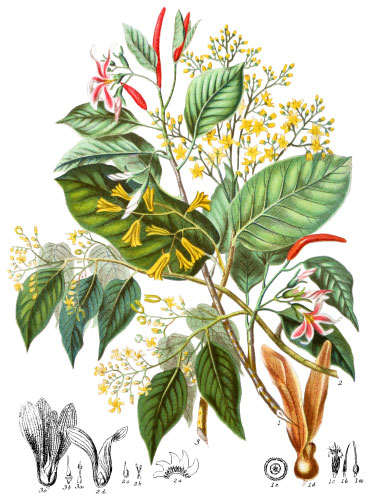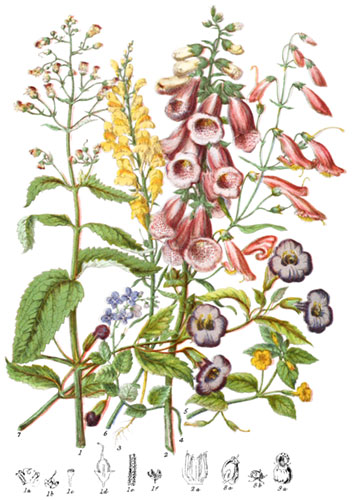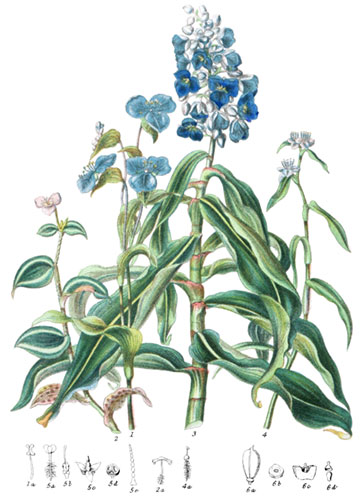Key characteristics
All herbacious plants, either annual or perennial, with slender fragile stems, containing a milky juice. The leaves are usually alternate, much divided in a ternate manner: some species have twisted leaf-stalks, like tendrils, by means of which they climb over other plants. The flowers are very irregular; the calyx is formed of two small acute membranous sepals placed opposite each other; the petals are four in number, more or less combined in a tube, one or two of them having a spur or pouch at the base, forming a nectary; the two side petals are within the others, and are slightly united by their tips. The stamens are either four or six, divided into two sets, opposite the outer petals, very seldom all separate; the anthers are membranous, the outer one of each set is one-celled, the middle one two-celled. The ovary is terminated by a slender style, and a stigma of two compressed lobes, with two or more points. The seed-vessel is either a closed nut containing one or two polished crested seeds, as in Fumaria, or a pod with two valves and many seeds, as in Corydalis, or a succulent closed pod with two seeds, as in Carcocapnos: in this Order is seen every gradation from a one-seeded to a many-seeded pod.
Fumaria resembles in some points Epimedium, thus forming a link with the Berberry tribe. Hypecoum shows an affinity with the Poppy tribe, but an important difference exists in the juice of Fumitoriess being watery, that of Poppies milky.
The general character of the Fumitory tribe is to be slightly bitter, scentless, and without any milky juice.
Select plants in this order
Not all plants listed are illustrated and not all plants illustrated are listed.
- Fumaria capreolata (1) grows plentifully in various parts of England, climbing often to the height of three or four feet with its twisting leaf-stalks on the other plants; the globose pod contains a single seed. Corydalis is the old Greek name for these plants.
- Corydalis lutea (2) is found among the ruins of Fountain’s Abbey, and in a few other localities in Yorkshire, and in Derbyshire; the stems are extremely brittle, the fibrous roots penetrate easily among the stones of old walls, where it flourishes: this renders it a suitable plant for rock-work in gardens, although it spreads too rapidly, as the seed-vessels ripen and scatter their seeds in great profusion.
- Corydalis tuberosa (3) is remarkable for its hollow root, which has been ascertained to contain a peculiar alkali called Corydalin.
- Corydalis solida, occasionally found in woods in Westmoreland, and frequently on the Continent, has a fleshy root, which is said to afford food to the poor Kalmucks in their wintery scarcity.
- Corydalis Cashmeriana (5) is one of the fifteen species that have been discovered on the range of the Himalayas, from Nepal to Cashmere; it is a small plant, and bears but few flowers on the erect simple stalk, but is of pleasing aspect from the colouring.
- C. Goviana is very common on the Choor Mountains of the Himalayas, at 8000 feet elevation; the Hill people esteem it a valuable charm against the influence of evil spirits.
- The tuberous root of C. bulbosa was formerly used as a medicine, being bitter, astringent, and slightly aromatic.
- C. nobilis, from Siberia, is a hardy flower in English gardens.
- A species of Fumaria, nearly resembling F. parviflora of Europe, is taken in India as a remedy for ague, when mixed with black pepper.
- The genus Diclytra was so named from the two spurs or pouches; the several hardy species of our gardens are from North America.
- Diclytra spectabilis, lately brought from China by Mr. Fortune, is one of the finest of this tribe, bearing long racemes of elegant pink flowers.
- Sarcocapnos enneaphylla of Spain differs in foliage from the usual form in this tribe, the leaves being of a fleshy substance, and divided simply into three triple divisions.
- Cysticapnos Africana, of the Cape, has also simple triple leaflets.
- Adlumia is an annual plant from North America, climbing to the height of fifteen feet, with rapid growth.
- Dactylicapnos is a climbing species belonging to the Himalayas, distinguished by its fleshy oblong berries.
- Dicentra cucullaria is employed medicinally in North America.
Locations
The plants of this tribe are dispersed chiefly over the temperate and cold regions of the Northern hemisphere, growing in woods and waste places. Like many tribes belonging to temperate climates, it extends in a few scattered species over the middle regions of the Himalayas. One species alone is found on the plains of India, flowering only in the cold season. Two species belong to the Cape of Good Hope.
Legend
- Fumaria capreolata, Ramping Fumitory. England.
- Flower partly separated.
- Seed-vessel.
- Seed.
- Corydalis lutea, Yellow Corydalis. England.
- Corydalis tuberosa, Hollow-rooted Corydalis. Europe.
- Stamens.
- Pistil.
- Seed-vessel.
- Seed-vessel, open.
- Diclytra formosa, Blush Diclytra. N. America.
- Corydalis Cashmeriana, Cashmere Corydalis. Himalayas
Explore more
Posters
Decorate your walls with colorful detailed posters based on Elizabeth Twining’s beautiful two-volume set from 1868.
Puzzles
Challenge yourself or someone else to assemble a puzzle of all 160 botanical illustrations.
